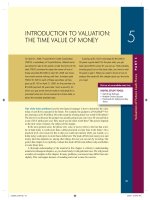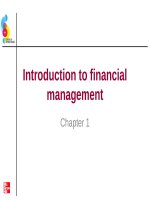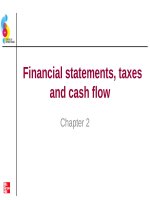Lecture Essentials of corporate finance (2/e) – Chap 4: Introduction to valuation: the time value of money
Bạn đang xem bản rút gọn của tài liệu. Xem và tải ngay bản đầy đủ của tài liệu tại đây (275.04 KB, 47 trang )
Introduction to valuation:
The time value of money
Chapter 4
4-1
Key concepts and skills
Be able to compute the following:
• The future value of an investment made today
• The present value of cash to be received at some future
date
• The return on an investment
Be able to predict how long it will take for an investment
to
reach a desired value
Be able to solve time value of money problems using:
• formulas
• a financial calculator
2011 McGraw-Hill Australia Pty Ltd
• aCopyright
spreadsheet
PPTs t/a Essentials of Corporate Finance 2e by Ross et al.
Slides prepared by David E. Allen and Abhay K. Singh
4-2
Chapter outline
• Future value and compounding
• Present value and discounting
• More on present and future values
Copyright © 2011 McGraw-Hill Australia Pty Ltd
PPTs t/a Essentials of Corporate Finance 2e by Ross et al.
Slides prepared by David E. Allen and Abhay K. Singh
4-3
Basic definitions
• Present value
(PV)
– The current value of future cash flows
discounted at the appropriate discount
rate.
– Value at t=0 on a time line
• Future value
(FV)
– The amount an investment is worth after
one or more periods.
– ‘Later’ money on a time line
Copyright 2011 McGraw-Hill Australia Pty Ltd
PPTs t/a Essentials of Corporate Finance 2e by Ross et al.
Slides prepared by David E. Allen and Abhay K. Singh
4-4
Basic definitions (cont.)
• Interest rate (r)
– Discount rate
– Cost of capital
– Opportunity cost of capital
– Required return
– Terminology depends on usage
Copyright 2011 McGraw-Hill Australia Pty Ltd
PPTs t/a Essentials of Corporate Finance 2e by Ross et al.
Slides prepared by David E. Allen and Abhay K. Singh
4-5
Future values: General
formula
• FV = PV(1 + r)t
– FV = Future value
– PV = Present value
– r = Period interest rate, expressed as a
decimal
– T = Number of periods
• FVIF(r,t)=Future value interest factor for
$1 invested at r% for t periods
• Future value interest factor = (1 + r) t
x
• Calculator
note:
y
key
Copyright 2011 McGraw-Hill Australia Pty Ltd
PPTs t/a Essentials of Corporate Finance 2e by Ross et al.
Slides prepared by David E. Allen and Abhay K. Singh
4-6
Time line of cash flows
•Tick marks at ends of periods
• Time 0 is today
• Time 1 is the end of Period 1
0
1
2
3
r%
CF0
CF1
CF2
+CF = Cash INFLOW -CF = Cash OUTFLOW
Copyright 2011 McGraw-Hill Australia Pty Ltd
PPTs t/a Essentials of Corporate Finance 2e by Ross et al.
Slides prepared by David E. Allen and Abhay K. Singh
PMT = Constant CF
4-7
Time line for a $100 lump sum due
at the end of year 2
0
r%
1
2 Year
100
Copyright 2011 McGraw-Hill Australia Pty Ltd
PPTs t/a Essentials of Corporate Finance 2e by Ross et al.
Slides prepared by David E. Allen and Abhay K. Singh
4-8
Future values: Example 1
• Investing for a single period
– Suppose you invest $100 for one year at 10% (r)
per year. What is the future value in one year?
• Interest = 100(.1) = $10
• Value in one year = principal + interest = 100 + 10 = $110
• Future value (FV) = 100(1 + .1) = $110
• Investing for more than one period
– Suppose you leave the money in for another year.
How much will you have two years from now?
• FV = 100(1.1)(1.1) = 1000(1.1)2 = $121
Copyright 2011 McGraw-Hill Australia Pty Ltd
PPTs t/a Essentials of Corporate Finance 2e by Ross et al.
Slides prepared by David E. Allen and Abhay K. Singh
4-9
Future values:
Effects of compounding
• Simple interest
– Interest earned only on the original
principal
• Compound interest
– Interest earned on principal and on
interest received
– ‘Interest on interest’—interest earned
on reinvestment of previous interest
payments
Copyright 2011 McGraw-Hill Australia Pty Ltd
PPTs t/a Essentials of Corporate Finance 2e by Ross et al.
Slides prepared by David E. Allen and Abhay K. Singh
4-10
Future values:
Effects of compounding
• Consider the previous example:
– FV w/simple interest
= 100 + 10 + 10 = 120
– FV w/compound interest
=100(1.10)2 = 121.00
– The extra 1.00 comes from the
interest of .10(10) = 1.00 earned on
the first interest payment.
Copyright 2011 McGraw-Hill Australia Pty Ltd
PPTs t/a Essentials of Corporate Finance 2e by Ross et al.
Slides prepared by David E. Allen and Abhay K. Singh
4-11
Future values of $100 at 10%
Copyright 2011 McGraw-Hill Australia Pty Ltd
PPTs t/a Essentials of Corporate Finance 2e by Ross et al.
Slides prepared by David E. Allen and Abhay K. Singh
4-12
Future values:
Simple interest and compound
Interest
Copyright 2011 McGraw-Hill Australia Pty Ltd
PPTs t/a Essentials of Corporate Finance 2e by Ross et al.
Slides prepared by David E. Allen and Abhay K. Singh
4-13
Future value of $1 for different
interests and rates
Copyright 2011 McGraw-Hill Australia Pty Ltd
PPTs t/a Essentials of Corporate Finance 2e by Ross et al.
Slides prepared by David E. Allen and Abhay K. Singh
4-14
Calculating future value
• Using a calculator
– Calculator key: yx
• Using the Future Value Factor Table
– Table 4.2
Copyright 2011 McGraw-Hill Australia Pty Ltd
PPTs t/a Essentials of Corporate Finance 2e by Ross et al.
Slides prepared by David E. Allen and Abhay K. Singh
4-15
Future value: Calculator
hints
• Texas Instruments BA-II Plus
– FV = Future value
– PV = Present value
– I/Y = Period interest rate
• PV must equal 1 for the I/Y to be the period
rate
• Interest is entered as a percentage, not a
decimal
– N = Number of periods
– Remember to clear the registers (CLR
TVM) after each problem.
– Other calculators are similar in format.
Copyright 2011 McGraw-Hill Australia Pty Ltd
PPTs t/a Essentials of Corporate Finance 2e by Ross et al.
Slides prepared by David E. Allen and Abhay K. Singh
4-16
Future value: Example 2
• Suppose you invest the $100 from the previous
example for 5 years. How much would you
have?
– Formula solution:
• FV=PV(1+r)t=100(1.10)5=161.05
• The effect of compounding is small for a small
number of periods, but increases as the number
of periods increases.
– Key strokes :
•
•
•
•
•
N=5,
I/Y=10
PV=-100
CPT-FV
FV=161.05
Copyright 2011 McGraw-Hill Australia Pty Ltd
PPTs t/a Essentials of Corporate Finance 2e by Ross et al.
Slides prepared by David E. Allen and Abhay K. Singh
4-17
Future value: Example 3
• Suppose you had a relative deposit $5
at 6% interest 200 years ago. How
much would the investment be worth
today?
– FV = 5(1.06)200 = $575 629.50
• What is the effect of compounding?
– Simple interest = 5 + 200(5)(.06) =
5+60=65
– Compounding added $575564.5 to the
Copyright 2011 McGraw-Hill Australia Pty Ltd
ofof Corporate
the investment.
PPTsvalue
t/a Essentials
Finance 2e by Ross et al.
Slides prepared by David E. Allen and Abhay K. Singh
4-18
Quick quiz: Part 1
• What is the difference between simple
interest and compound interest?
• Suppose you have $500 to invest and
you believe that you can earn 8% per
year over the next 15 years.
– How much would you have at the end of
15 years using compound interest?
– How much would you have using simple
interest?
Copyright 2011 McGraw-Hill Australia Pty Ltd
PPTs t/a Essentials of Corporate Finance 2e by Ross et al.
Slides prepared by David E. Allen and Abhay K. Singh
4-19
Present value and
discounting
• The current value of future cash flows
discounted at the appropriate discount
rate
• Value at t=0 on a time line
• Answers the questions:
– How much do I have to invest today to
have a particular amount in the future?
– What is the current value of a particular
amount to be received in the future?
Copyright 2011 McGraw-Hill Australia Pty Ltd
PPTs t/a Essentials of Corporate Finance 2e by Ross et al.
Slides prepared by David E. Allen and Abhay K. Singh
4-20
Present value
• Present value = the current value of an
amount to be received in the future.
• Why is it worth less than face value?
– Opportunity cost
– Risk and uncertainty
– Discount rate = ƒ (time, risk)
Copyright 2011 McGraw-Hill Australia Pty Ltd
PPTs t/a Essentials of Corporate Finance 2e by Ross et al.
Slides prepared by David E. Allen and Abhay K. Singh
4-21
Present value (cont.)
FV = PV(1 + r)t
• Rearrange to solve for basic present
value equation
PV = FV / (1+r)t
PV = FV(1+r)-t
• ‘Discounting’ = finding the present value of
one or more future amounts.
• (1+r)-t is the present value factor.
Copyright 2011 McGraw-Hill Australia Pty Ltd
PPTs t/a Essentials of Corporate Finance 2e by Ross et al.
Slides prepared by David E. Allen and Abhay K. Singh
4-22
Present value
Example 1—Single period
• Suppose you need $400 to buy textbooks
next year. You can earn 7% on your
money. How much do you have to put up
today?
– Formula solution:
• PV=FV(1+r)-t=400/(1+0.07)
• PV= 373.83
– Calculator keys:
• 1N
• 7 I/Y
• 400 FV
• CPT
PV = -373.83
Copyright
2011 McGraw-Hill
Australia Pty Ltd
PPTs t/a Essentials of Corporate Finance 2e by Ross et al.
Slides prepared by David E. Allen and Abhay K. Singh
4-23
Present value
Example 2—Multiperiod
• You would like to buy a new car. You have $50
000, but the car costs $68 500. If you can earn
9%, how much do you have to invest today to buy
the car in two years? Do you have enough?
Assume the price will stay the same.
– PV=FV/(1+r) t
– =68500/(1.09)2
– 57655.08, so still short of the required amount by
$7655
• Calculator keys:
•
•
•
•
2N
9 I/Y
68500 FV
CPT PV = -57655.08
Copyright 2011 McGraw-Hill Australia Pty Ltd
PPTs t/a Essentials of Corporate Finance 2e by Ross et al.
Slides prepared by David E. Allen and Abhay K. Singh
4-24
Present value
Example 3—Multiperiod
• Your parents set up a trust fund for you
10 years ago that is now worth $19
671.51. If the fund earned 7% per year,
how much did your parents invest?
– PV = 19 671.51 / (1.07)10 = $10 000
• Calculator keys:
•
•
•
•
10 N
7 I/Y
19671.51 FV
CPT PV = -10000
Copyright 2011 McGraw-Hill Australia Pty Ltd
PPTs t/a Essentials of Corporate Finance 2e by Ross et al.
Slides prepared by David E. Allen and Abhay K. Singh
4-25









